You’ve probably admired a perfectly cut gemstone without considering the journey it took to reach your hands. Behind that brilliant sparkle lies a complex web of decisions that can either support ethical practices or contribute to environmental damage and social harm. When you choose gemstones, you’re not just selecting a beautiful piece – you’re casting a vote for the methods used to extract, process, and shape these precious stones, making your purchasing power a catalyst for industry-wide change.
Understanding Ethical Sourcing in Gemstone Procurement
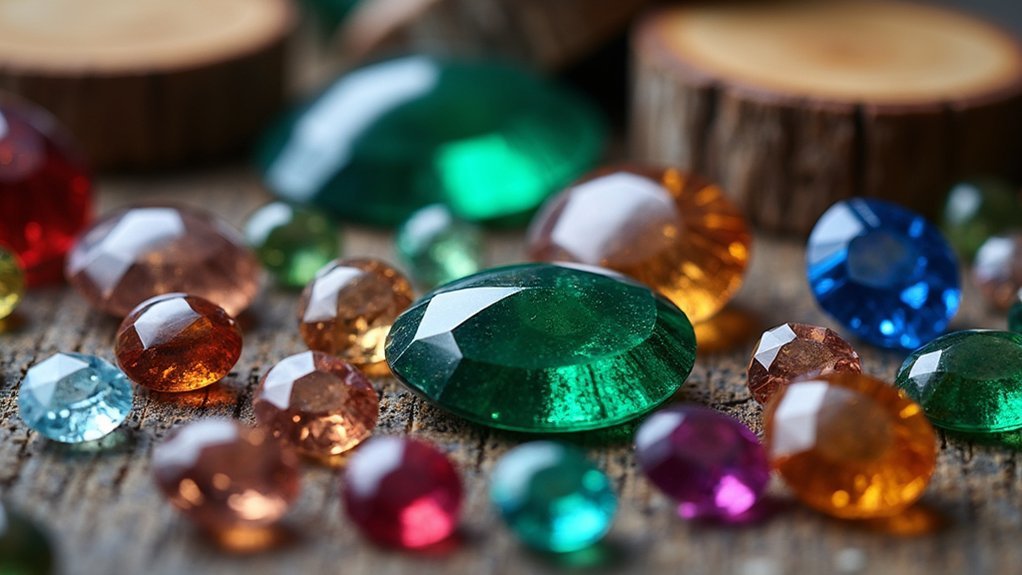
When you’re selecting gemstones for cutting, understanding their origin becomes as essential as evaluating their physical properties. Ethical sourcing guarantees you’re working with conflict-free stones that don’t fund violence or human rights violations.
You’ll want to verify certifications like the Kimberley Process for diamonds and seek suppliers following Responsible Jewellery Council guidelines.
Responsible gem sourcing involves tracing supply chains to confirm fair labor practices and environmental sustainability. You’re supporting artisanal miners when you choose suppliers who promote safe working conditions and fair wages in mining communities.
Supporting ethical suppliers means choosing partners who prioritize miner safety, fair wages, and sustainable practices throughout the gemstone supply chain.
The art of gem cutting becomes more meaningful when you know your materials support positive change.
Consider lab-grown alternatives that eliminate mining-related issues while maintaining the beauty and quality essential for your cutting projects.
Conflict-Free Certification and Supply Chain Transparency
You’ll need to understand certification standards that verify your gemstones come from conflict-free sources and meet ethical sourcing requirements.
These standards require thorough traceability documentation that tracks each stone’s journey from mine to market.
You can’t guarantee responsible cutting practices without first confirming your raw materials meet these transparency and certification benchmarks.
Certification Standards Overview
Transparency has become the cornerstone of ethical gemstone sourcing, with certification standards now providing clear pathways for tracking stones from mine to market.
When you’re purchasing cut gemstones, you’ll encounter several key certification programs that guarantee ethical sourcing practices.
The Kimberley Process Certification Scheme stands as the most recognized standard for rough diamonds, requiring documentation from origin countries to prevent conflict stones from entering markets.
You’ll also find the Responsible Jewellery Council (RJC) setting extensive standards that members must follow regarding ethical, human rights, and environmental practices throughout the entire supply chain.
These certification standards respond directly to increased consumer demand for responsibly sourced materials.
They create accountability frameworks that allow you to verify your gemstones’ ethical journey from extraction to final purchase.
Traceability Documentation Requirements
While certification standards establish the framework for ethical sourcing, detailed traceability documentation creates the paper trail that proves your gemstone’s conflict-free status.
You’ll need extensive records showing your stone’s complete journey from mine to market, including mining location details, ownership transfers, and transportation methods used throughout the supply chain.
When you’re purchasing conflict-free gemstones, look for suppliers who provide transparent documentation of their sourcing practices.
Many responsible jewelers now use blockchain technology to create permanent, unalterable records of each gemstone’s provenance.
This digital traceability documentation guarantees you can verify the ethical sourcing of your purchase while supporting suppliers committed to transparency.
These detailed records help you make informed decisions and promote accountability across the entire gemstone industry.
Fair Labor Practices in Mining and Cutting Operations
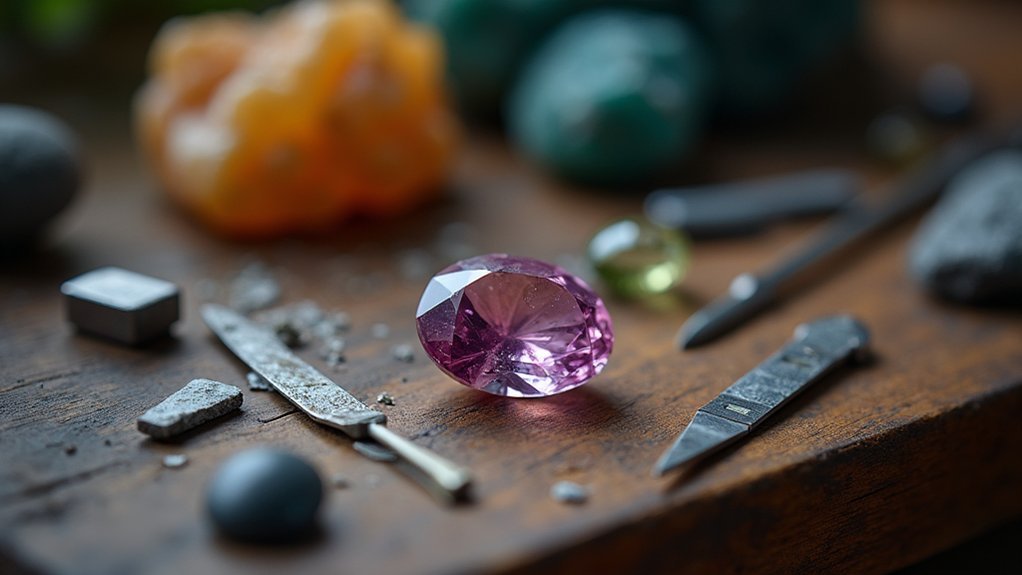
When you choose ethically sourced gemstones, you’re supporting mining and cutting operations that prioritize fair labor practices and worker welfare.
These operations assure workers receive living wages of at least $10 per day, dramatically improving livelihoods compared to average regional incomes.
Ethical trade organizations now certify many gemstone companies, auditing supply chains to confirm compliance with safety standards and child labor prohibition.
This transparency in sourcing drives increased productivity and morale, as fair wages enhance job satisfaction and reduce turnover rates.
Key benefits of fair labor practices include:
- Worker cooperatives allowing miners collective ownership for better economic outcomes
- Enhanced community investment through improved worker conditions
- Consumer support, with 66% willing to pay premium prices for ethically sourced gems
Environmental Impact Reduction in Cutting Processes
Beyond ensuring fair wages and worker welfare, responsible gemstone operations focus intensively on minimizing their environmental footprint through innovative cutting processes.
You’ll find that modern facilities prioritize water-based coolants over oils, reducing pollution while conserving precious water resources during the cutting process. Advanced dust collection systems capture harmful particles, protecting both air quality and worker health throughout gemstone cutting operations.
Laser cutting technology revolutionizes waste reduction by maximizing usable portions of rough stones, greatly decreasing discarded material.
You can also expect sustainable operations to utilize energy-efficient machinery powered by renewable sources like solar panels, considerably reducing their carbon footprint.
Most importantly, ethical practices extend to sourcing rough stones from environmentally responsible mines that prioritize land reclamation and biodiversity conservation, ensuring minimal environmental impact.
Waste Minimization Techniques During Gem Processing
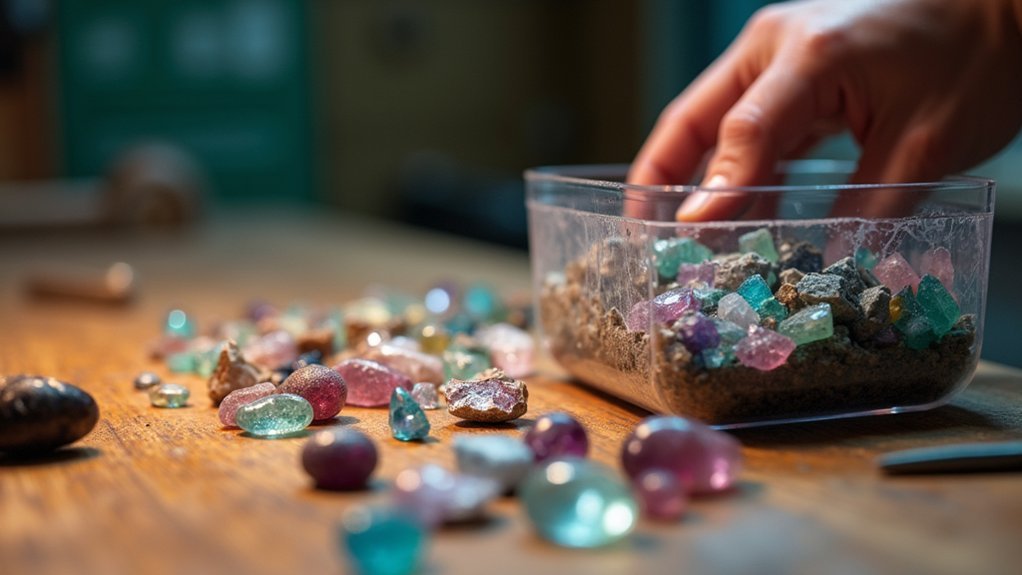
You’ll maximize your gem yield by carefully analyzing each rough stone’s natural structure before making any cuts, potentially reducing waste by up to 80%.
Advanced software like GemCad lets you simulate different cutting approaches digitally, helping you choose the most efficient design before touching the actual stone.
Don’t overlook the value in recovering small fragments and diamond dust from your cutting process—these materials can be recycled for future polishing and cutting tasks.
Strategic Rough Stone Planning
Although rough gemstones may appear unremarkable in their natural state, strategic planning transforms them into valuable treasures through careful assessment and precise cutting techniques.
You’ll find that gem cutters begin by evaluating color, clarity, and size to maximize high-quality yields while minimizing waste during cutting and polishing processes.
Strategic planning involves several key approaches:
- Computer modeling software like GemCad helps design ideal cuts that retain maximum carat weight from rough stones.
- Pre-forming and trial runs identify the best angles before actual cutting begins.
- Advanced laser cutting technology enables precise cuts that minimize material loss.
You can also plan for creating secondary gems from initial rough stones, maximizing overall value.
This all-encompassing approach guarantees every piece of valuable material is utilized effectively, transforming raw potential into finished gemstones.
Advanced Cutting Technology Benefits
Modern cutting technology revolutionizes how you can minimize waste during gem processing, building directly on the strategic planning foundation with tools that deliver unprecedented precision.
Advanced cutting technology like laser systems targets ideal angles and dimensions, maximizing yield from your rough stones through precise calculations.
You’ll benefit from CAD software that lets you simulate cuts virtually, exploring various designs before making actual cuts.
Water jet cutting employs high-pressure streams for cleaner cuts without excessive grinding, preserving more material.
Automated faceting machines eliminate human error while maintaining consistency.
When you implement modified cuts tailored to rough material characteristics, you’ll enhance overall yield considerably.
These technologies reduce environmental impact by maximizing how much usable material you extract from each stone, making your cut stones more sustainable.
Recovery of Small Fragments
While advanced cutting technology maximizes your initial yields, capturing and repurposing the inevitable fragments and dust generated during processing becomes equally essential for sustainable gemstone work.
You’ll find that collecting gem dust during various gem cutting styles creates valuable opportunities for secondary applications. These tiny particles shouldn’t be discarded—they’re perfect for creating inlay work, mixing into resin projects, or developing smaller decorative pieces.
Key recovery strategies include:
- Systematic collection systems that capture fragments during sawing and grinding operations
- Tumbling processes that transform irregular chips into polished beads and cabochons
- Specialized equipment like vacuum collection units that gather the finest particles
Energy-Efficient Cutting Technologies and Equipment
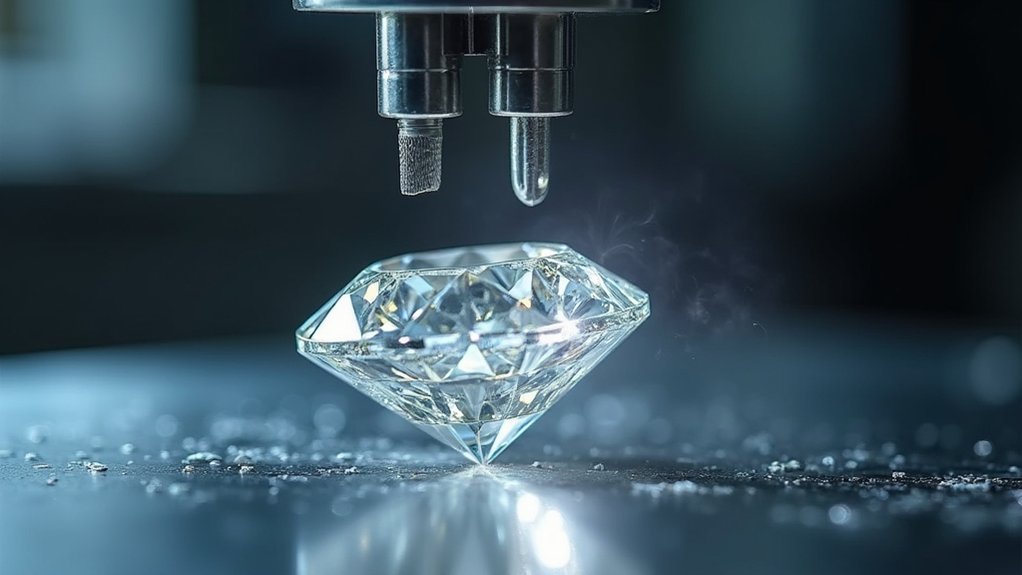
When you’re selecting gemstone cutting equipment, energy-efficient cutting technologies can dramatically reduce your environmental impact while maintaining precision and quality.
Laser cutting systems utilize focused light beams that minimize waste and consume less energy than traditional methods. Advanced diamond saws with variable speed controls optimize power usage while delivering precise cuts, reducing overall energy requirements for your operations.
CNC machines offer exceptional accuracy in cutting patterns, maximizing yield from rough stones and reducing energy needed for subsequent polishing.
You’ll also benefit from water-cooled grinding wheels that maintain lower temperatures, extending equipment life while using less energy. Implementing variable frequency drives enhances efficiency by adjusting motor speed based on load requirements, delivering significant energy savings throughout your cutting operations.
Water Conservation Methods in Polishing Operations
You can dramatically reduce your water consumption during polishing operations by implementing coolant recycling systems that filter and reuse water continuously.
These closed-loop systems prevent waste while maintaining the quality you need for precision gem polishing.
You’ll also benefit from adopting minimal water techniques that use eco-friendly compounds requiring less rinsing between polishing stages.
Coolant Recycling Systems
As you implement coolant recycling systems in your gemstone polishing operations, you’ll discover these technologies can recover up to 90% of your water usage through sophisticated collection and filtration processes.
These systems transform how you approach polishing gemstones by dramatically reducing water consumption while maintaining cutting efficiency.
When you adopt coolant recycling as part of your sustainable practices, you’ll benefit from:
- Reduced environmental impact through minimized chemical additive usage
- Lower operational costs from decreased water bills and disposal fees
- Enhanced equipment efficiency with modern machines featuring built-in recycling capabilities
You’ll find that many contemporary polishing machines come equipped with integrated coolant recycling systems, making eco-friendly practices more accessible.
Minimal Water Techniques
Innovation in minimal water techniques revolutionizes how you approach gemstone polishing by drastically cutting water consumption without compromising quality.
You’ll find that implementing closed-loop systems recycles water continuously, minimizing waste and environmental impact remarkably. Advanced polishing machines with water misting systems deliver effective cooling and lubrication while using considerably less water than traditional methods.
You can eliminate water entirely by adopting dry polishing methods with diamond-impregnated pads, conserving resources and reducing pollution.
When you utilize eco-friendly abrasives and polishing compounds, you’ll require less water for application and cleanup procedures. Regular maintenance and optimization of your polishing equipment guarantees efficient water use, helping you achieve sustainability goals while maintaining exceptional gemstone finishes throughout your operations.
Supporting Local Communities Through Responsible Partnerships

While traditional gemstone cutting often prioritizes profit margins over ethical considerations, responsible cutting methods create meaningful partnerships that directly benefit the communities providing raw materials.
Ethical gemstone cutting transforms profit-driven practices into community partnerships that prioritize fair wages and sustainable development over pure financial gain.
When you choose responsible cutting practices, you’re supporting local economies through fair trade partnerships. These ethical collaborations guarantee miners receive fair wages and improved working conditions, creating sustainable livelihoods for entire communities.
Consider these key benefits of responsible partnerships:
- Community investment – Organizations fund education, healthcare, and infrastructure projects that improve quality of life.
- Cultural preservation – Collaboration with local artisans maintains traditional lapidary techniques and craftsmanship heritage.
- Environmental protection – Sustainable mining practices reduce ecological damage while promoting responsible land use.
Traceability Systems for Gemstone Origin Verification
Despite the jewelry industry’s complex global supply chains, modern traceability systems now enable you to verify your gemstone’s complete journey from mine to market. These systems use blockchain technology to create permanent records tracking each stone through cutting, certification, and distribution phases.
| Technology | Function | Benefit |
|---|---|---|
| Blockchain | Immutable record keeping | Prevents fraud and tampering |
| RFID Tags | Real-time tracking | Monitors location during cut processes |
| Digital Certificates | Origin authentication | Validates ethical sourcing claims |
| QR Codes | Consumer access | Instant verification at purchase |
| GPS Logging | Mine location data | Confirms extraction coordinates |
You’ll find certification bodies like GIA and RJC provide standards ensuring responsible practices. With 70% of millennials demanding transparency, traceability systems let you purchase gemstones confidently, knowing their ethical origins and environmental impact throughout the cutting and distribution process.
Sustainable Workshop Practices for Lapidary Artists
As environmental consciousness reshapes the jewelry industry, you can transform your lapidary workshop into a sustainable operation that preserves both craftsmanship and our planet’s resources.
Start by sourcing rough stones from ethical mining operations that guarantee fair labor conditions and minimal environmental disruption. You’ll want to implement water-efficient cutting techniques like dry cutting or advanced cooling systems to reduce waste and conserve this precious resource.
- Switch to eco-friendly polishing agents derived from natural materials instead of harsh chemicals
- Install energy-efficient machinery to reduce your carbon footprint while maintaining quality standards
- Collaborate with local artisans to support traditional cutting techniques and responsible sourcing practices
These sustainable practices don’t compromise your craftsmanship—they enhance it by connecting your work to responsible stewardship and cultural preservation.
Eco-Friendly Cutting Compounds and Materials
Beyond implementing sustainable workshop practices, you’ll discover that selecting the right eco-friendly cutting compounds and materials can dramatically reduce your environmental impact without sacrificing precision or finish quality.
| Material Type | Eco-Friendly Option | Environmental Benefit |
|---|---|---|
| Abrasives | Silicon carbide, aluminum oxide | Natural minerals vs synthetic alternatives |
| Lubricants | Organic-based coolants | Biodegradable, minimizes pollution |
| Equipment | Recycled diamond saw blades | Repurposes existing materials |
You’ll find natural abrasives like silicon carbide deliver excellent cutting performance while being less harmful than synthetic compounds. Switching to biodegradable lubricants made from organic materials reduces waste contamination. Recycled diamond blades and grinding wheels help minimize manufacturing waste. Advanced laser cutting techniques also produce less material waste, maximizing your rough gemstone usage while maintaining professional results.
Artisanal Mining Support and Small-Scale Producer Benefits
While choosing responsible materials forms one pillar of ethical gemstone cutting, you’ll make an even greater impact by sourcing your rough stones from artisanal miners and small-scale producers.
These operations support local economies by creating jobs and improving living standards within mining communities.
Supporting artisanal miners creates meaningful employment opportunities that directly strengthen local communities and improve quality of life.
When you partner with small-scale producers, you’re investing in:
- Environmental protection – Traditional mining techniques minimize ecological damage compared to industrial operations
- Cultural preservation – Generations-old cutting methods maintain heritage while promoting sustainable practices
- Community development – Profits fund local infrastructure, education, and healthcare improvements
Artisanal mining operations typically offer fair trade practices, ensuring better wages and working conditions for miners.
Long-Term Environmental Restoration and Mining Site Rehabilitation
When gemstone cutting operations conclude, the real test of environmental responsibility begins with thorough site rehabilitation that transforms exhausted mining areas into thriving ecosystems. You’ll find that extensive environmental restoration requires strategic planning using native plant species for biodiversity and soil stabilization.
Mining site rehabilitation follows established protocols that you can implement:
| Phase | Technique | Timeline | Purpose | Outcome |
|---|---|---|---|---|
| Assessment | Environmental Impact Analysis | 6-12 months | Damage evaluation | Restoration roadmap |
| Soil Recovery | Remediation practices | 1-3 years | Contamination removal | Healthy foundation |
| Vegetation | Native reforestation | 3-5 years | Ecosystem rebuilding | Wildlife habitat |
| Water Systems | Wetland restoration | 2-4 years | Hydrology repair | Clean water sources |
| Repurposing | Sustainable uses development | 5+ years | Community benefit | Economic opportunities |
You’re creating lasting positive impact through responsible rehabilitation practices.
Frequently Asked Questions
What Are the Different Ways to Cut Gems?
You’ll cut gems through sawing with diamond-embedded blades, grinding for shaping, sanding to smooth surfaces, and polishing for brilliance. You can also use specialty techniques like cabochon cutting and faceting for unique designs.
What Are the Three Types of Gem Cutting Lapidary )?
You’ll encounter three main gem cutting types in lapidary work: brilliant cuts with triangular facets maximizing sparkle, step cuts featuring rectangular stair-step facets emphasizing clarity, and mixed cuts combining both styles.
Which Gemstone Cut Is Best?
You’ll find the Round Brilliant cut’s the best overall choice for maximum sparkle and light return. However, if you’re prioritizing clarity showcase, you should consider the Emerald cut instead.
What Are the Different Types of Gem Faceting?
You’ll find five main gem faceting types: brilliant cuts with maximum sparkle, step cuts emphasizing clarity, mixed cuts combining both styles, specialty cuts offering unique shapes, and simple cuts for basic enhancement.
In Summary
You’ll make a meaningful difference by choosing responsible gemstone cutting methods that prioritize ethical sourcing, environmental protection, and fair labor practices. You’re supporting conflict-free certification, sustainable workshop operations, and waste reduction techniques that benefit both communities and ecosystems. When you embrace eco-friendly cutting compounds, back artisanal miners, and invest in long-term environmental restoration, you’re contributing to a more sustainable and ethical gemstone industry that’ll preserve resources for future generations.

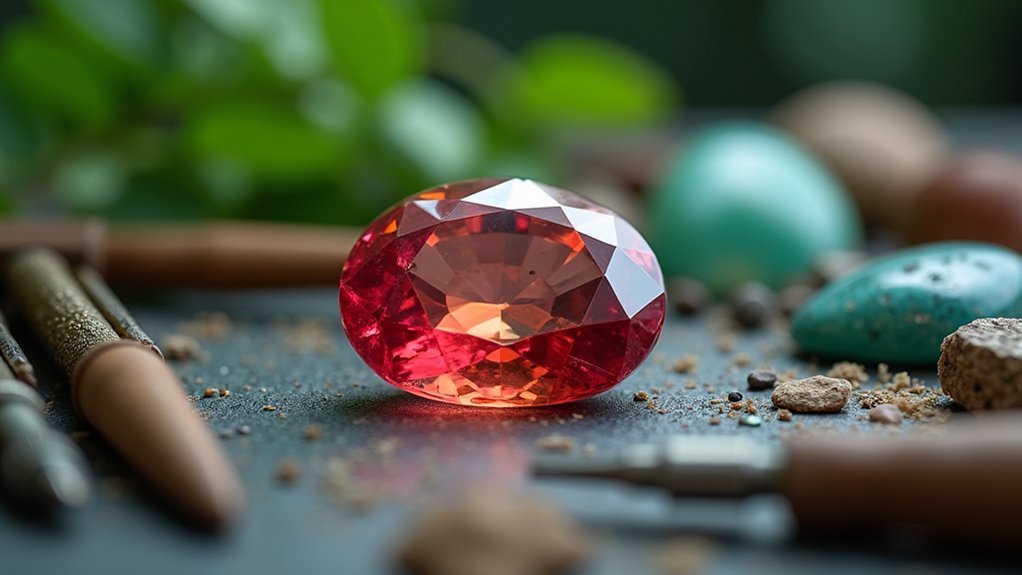



Leave a Reply